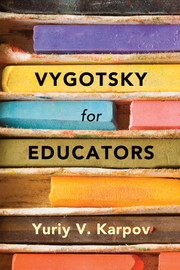Book contents
- Frontmatter
- Dedication
- Contents
- List of Figures
- Acknowledgments
- Introduction
- Part I Mediation from Birth through Adolescence
- Part II School: What to Teach and How to Teach
- 8 American Cognitive Psychologists and Russian Vygotskians talk about the Content and Process of Learning at School
- 9 What Do Students Learn in “Traditional” Schools?
- 10 Does Constructivist Instruction Present a Good Alternative to “Traditional” Teaching?
- 11 The Vygotskian Theoretical Learning Approach as an Alternative to “Traditional” Explicit Instruction and to Constructivist Instruction
- Conclusion
- Notes
- Index
9 - What Do Students Learn in “Traditional” Schools?
Published online by Cambridge University Press: 05 June 2014
- Frontmatter
- Dedication
- Contents
- List of Figures
- Acknowledgments
- Introduction
- Part I Mediation from Birth through Adolescence
- Part II School: What to Teach and How to Teach
- 8 American Cognitive Psychologists and Russian Vygotskians talk about the Content and Process of Learning at School
- 9 What Do Students Learn in “Traditional” Schools?
- 10 Does Constructivist Instruction Present a Good Alternative to “Traditional” Teaching?
- 11 The Vygotskian Theoretical Learning Approach as an Alternative to “Traditional” Explicit Instruction and to Constructivist Instruction
- Conclusion
- Notes
- Index
Summary
At first glance, the question in the chapter’s title sounds too general: Do not “traditional schools” in different countries (and even within the same country) differ? And is it not true that learning outcomes of “traditional school” students in different countries (and even within the same country) are quite different? This objection sounds especially valid in light of the comparisons of learning outcomes of American students with those of students in some other countries, which continue to be a serious concern of Americans since 1957, when the Soviet Union launched the Sputnik satellite. This technological victory of Soviet scientists over their American counterparts was attributed to superior math and science education in the Soviet Union and sparked serious changes in math and science curricula in the United States.
These days, it is the learning outcomes of the Finnish and South Korean (hereinafter “Korean”) students, not the Russians, that make American educators, policy makers and the general public concerned and envious. According to the data provided by the 2009 Program for International Student Assessment (PISA), American fifteen-year-olds rank 17th in science and 25th in math among their peers from 34 developed countries that belong to the Organization for Economic Co-Operation and Development (OECD). The highest-performing OECD countries are Korea (first rank in math and third in science) and Finland (second rank in math and first in science). These results are especially alarming because, as U.S. Secretary of Education Arne Duncan has indicated, “PISA assesses applied knowledge and the higher-order thinking skills critical to success in the information age.”
- Type
- Chapter
- Information
- Vygotsky for Educators , pp. 150 - 167Publisher: Cambridge University PressPrint publication year: 2014



